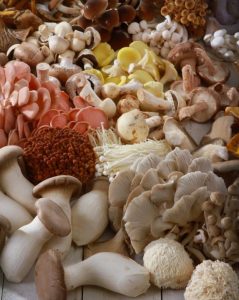How the Irish Cook with the Seasons: Embracing Seasonal Eating and Classic Irish Recipes
The farm is alive with movement.
Farmer Reuben spreads sweet smelling aged compost to restore the earth’s fertility—one of the most critical steps in regenerative farming. Compost isn’t just a way to nourish the soil for today’s crops; it’s an investment in future harvests.
Every clod of compost that flies off the spreader is a promise that we are preparing the land for growing optimally nutritious vegetables this season and beyond.
But we’re still in the in-between season.
It’s that time when winter’s hearty meals like Shepherd’s Pie and bone broth are still the perfect fit, as we wait for the early greens of spring to make their appearance.
I remember my realization while helping my dear friend Emily peel small, wrinkled potatoes that had been stored in her cellar since last summer’s harvest. They weren’t the most beautiful potatoes, and some were even starting to sprout. But you know what? They still made amazing mashed potatoes.
That was a turning point for me—a realization that in farming communities, there were no grocery stores to supplement what you had left. You used what you had, even if it wasn’t perfect. You didn’t toss out those “ugly” vegetables, and you certainly didn’t go hungry. You got creative.
The Importance of Eating Seasonally: A Look at Irish Traditions
That’s how classic Irish dishes like Shepherd’s Pie and Colcannon were born—not from abundance, but from necessity. In the lean months, when potatoes were all you had left, you made do. And you didn’t just use potatoes—those first greens of spring, like baby spinach or mustard greens, were vital for restoring the vitamins and minerals that our bodies crave after months of heavier winter meals. They helped replenish your energy, fight off sickness, and bring life back to your meals when the earth was just waking up.
As I walked out to the greenhouse this morning, I saw the first signs of life from the greens we’ve been growing—tiny, tender sprouts that will soon fill the tables with fresh flavor and nutrition.
These greens are the antidote to winter’s heavy fare. A reminder of the earth’s ability to renew itself and the importance of eating what is in season to nourish our bodies.
On the farm, it’s not all sunshine and smooth sailing, though.
We’ve been facing delays in our farm worker visas, an issue that’s affecting small farms across the country. It’s a real challenge and one we’re navigating as best we can.
Behind the scenes on the farm, in this video I’ll explain these challenges and the bounty you can look forward to soon.
Eating seasonally keeps us connected to the land and to the traditions that have fed generations before us.
So, as you make your meals this week, think of those wrinkled potatoes, the hearty greens, and the way our food connects us to the land beneath our feet.
Eating seasonally means making the most of what’s available—and right now, that means cooking up cozy, nourishing meals with storage veggies, hearty meats, and fresh greens.
Classic Irish dishes like Shepherd’s Pie and Colcannon are the perfect example of how Irish cooking has evolved to embrace seasonal ingredients, creating hearty and delicious meals.
Try this classic Shepherd’s Pie recipe, or get creative and experiment with different ingredients for a fresh twist!
Click here for the recipe!
Here’s a quick list of some more popular seaonal Irish dishes for the spring and St. Patrick’s Day:
- Any time of day: Irish Scones with raisins and caraway – made only by Vince Vercillo, Willow Haven Farm Bakery
- For breakfast, serve up some creamy Irish-Style Oatmeal with Brown Sugar or even a Traditional Full Irish Breakfast.
- Colcannon (mashed potatoes with cabbage or kale) is a fun and filling way to eat your greens!
- Did you remember to start your Corned Beef Brisket? If not, you can still get started and have it ready for a weekend feast. Follow Tessa’s recipe for great results!
- Tip: Use any leftovers for Corned Beef Hash.
- Boxty are Irish potato pancakes that are great for any meal.
- Irish Beef and Guinness Stew is perfectly comforting and hearty. Make this one with a stove, pressure cooker, or slow cooker.
- Dessert time! Chocolate Guinness Brownies are so rich and fudgy that you won’t even know they’re a healthy version of traditional Guinness Chocolate Cake.
MEAL IDEAS FOR YOUR LOCAL ORGANIC FOOD THIS WEEK:
Many of these recipes include produce or other items you may have received in your market box. You may also see ingredients you can purchase at the WHF General Store. Experiment and see what you can use to create your meal plan!
💡Pro tip: Always check your recipes to see what you have and what you need to purchase. Takes a few extra minutes in planning, but it beats finding out at the last minute that you’re missing ingredients!
FEATURED: Loaded Sweet Potatoes
This is one of the farm family’s favorite ways to serve sweet potatoes!
After roasting sweet potatoes whole, we serve them with butter, salt, pepper, caramelized onions, fried, crumbled spicy sausage, and shredded melty cheese like Gouda or Havarti.
Loaded sweet potatoes are a super versatile meal option – you can make them sweet, savory, light, or hearty. Try different combinations of toppings, sauce, and “extras” to create your own family favorites. Here are some ideas to get you started:
Savory – Great option for lunch or dinner. Serve with soup, a green salad, or sautéed greens if you want to fill out the meal even more.
Mushroom & Goat Cheese
- Toppings: Sautéed mushrooms, caramelized onions, goat cheese
- Sauce: Balsamic glaze
- Extras: Toasted walnuts, fresh thyme
BBQ Pulled Meat
- Toppings: Pulled BBQ chicken, pork, or beef
- Sauce: Smoky BBQ sauce
- Extras: Slaw (vinegar-based for contrast), crispy onions
- Tip: If you like a vegetarian option, try BBQ baked beans or pulled jackfruit in place of the meat.
Mediterranean Chickpea & Tahini
- Toppings: Roasted chickpeas, diced cucumbers or zucchini, cherry tomatoes, olives
- Sauce: Lemon-tahini drizzle
- Extras: Feta cheese, parsley, sumac
Southwest Black Bean & Avocado
- Toppings: Black beans, corn, diced tomatoes, avocado, cilantro
- Sauce: Lime crema or chipotle mayo
- Extras: Cotija cheese, pickled red onions, jalapeños
- Tip: For a meatier version, use any leftover ground or pulled meat you have on hand.
Sweet – Try these for breakfast or even dessert!
Maple Pecan Crunch
- Toppings: Toasted pecans, cinnamon, maple syrup
- Extras: Greek yogurt or coconut cream, a sprinkle of sea salt
Banana & Peanut Butter
- Toppings: Sliced banana, peanut butter drizzle, chia seeds
- Tip: Try variations like almond or cashew butter or hemp seeds
- Extras: Cacao nibs or dark chocolate chips/shavings
BREAD and BAKED GOODS:
- Looking for some St. Patrick’s Day goodies? Try Vince’s raisin caraway Irish scones. Yum!
- Don’t forget to add sourdough bread to your order to use for sandwiches, toast, or serving with soups and salads.
DAIRY:
- We now have organic buttermilk and heavy cream at the General Store for you!
- Tip: If you have leftover buttermilk or cream from a recipe, freeze it in ice cube trays and then store in a labeled freezer bag or container.
- Remember to check our cheese selection for your recipe needs – chevre, feta, mozzarella, and a variety of raw milk cheeses are available.
MEAT:
- Pastured, organic chicken is on sale! Stock up on breasts, legs, whole chickens, and necks/backs for broth.
- Looking for options for your Shepherd’s Pie recipe? We have ground lamb, beef, and pork. Beef or pork stew cubes are also great options.
- Tip: If you try the vegetarian Shepherd’s Pie, remember to add beets and lentils to your order.
PANTRY RECOMMENDATIONS:
- Several recipe ideas this week call for nuts – be sure to add what you need to your market box order.
- We also have chocolate chips for the delicious PB and banana sweet potato recipe above.
- Coconut milk and coconut flakes are available in our online store. We also have coconut cream available at the General Store – stop in to shop and say hello!
- If your recipe calls for olive oil or balsamic vinegar, we have several options for you.
FRUIT:
Storage for all apple varieties:
Keep unwashed apples in a plastic bag in the refrigerator’s crisper drawer, where they can stay fresh for up to two weeks.
 Apple, Crimson Crisp – This variety is known for its deep red skin, crisp texture, and balanced sweet-tart flavor. Crimson Crisp apples are an excellent source of dietary fiber and vitamin C. They also contain antioxidants that contribute to overall health. These medium-sized apples are perfect for fresh snacking, adding to salads, or using in baking due to their firm texture. Their balanced flavor makes them ideal for making applesauce, cider, or pies. Pair slices with cheese or nut butter for a delicious snack.
Apple, Crimson Crisp – This variety is known for its deep red skin, crisp texture, and balanced sweet-tart flavor. Crimson Crisp apples are an excellent source of dietary fiber and vitamin C. They also contain antioxidants that contribute to overall health. These medium-sized apples are perfect for fresh snacking, adding to salads, or using in baking due to their firm texture. Their balanced flavor makes them ideal for making applesauce, cider, or pies. Pair slices with cheese or nut butter for a delicious snack.
 Apples, Golden Delicious – Golden Delicious apples are a versatile variety with a sweet, mellow flavor and a crisp yet tender texture. They are high in fiber, vitamin C, and antioxidants, which support digestion, immune health, and skin health. These apples retain their shape and flavor, making them excellent for eating fresh, baking pies, making sauces, or adding to salads.
Apples, Golden Delicious – Golden Delicious apples are a versatile variety with a sweet, mellow flavor and a crisp yet tender texture. They are high in fiber, vitamin C, and antioxidants, which support digestion, immune health, and skin health. These apples retain their shape and flavor, making them excellent for eating fresh, baking pies, making sauces, or adding to salads.
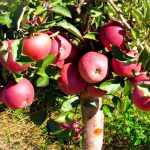 Apples, Pink Lady – Pink Lady apples are a crisp, juicy apple variety with a balanced sweet-tart flavor and a vibrant pinkish-red skin. They are high in fiber, vitamin C, and antioxidants, promoting heart health, immune support, and skin health. Pink Lady apples hold their shape well so they are great for snacking, adding to salads, or baking.
Apples, Pink Lady – Pink Lady apples are a crisp, juicy apple variety with a balanced sweet-tart flavor and a vibrant pinkish-red skin. They are high in fiber, vitamin C, and antioxidants, promoting heart health, immune support, and skin health. Pink Lady apples hold their shape well so they are great for snacking, adding to salads, or baking.
 Grapefruit – Grapefruit is a citrus fruit known for its juicy, tangy-sweet flavor with a slight bitterness. It is rich in vitamin C, fiber, and antioxidants like lycopene, promoting immune health, heart health, and skin health. Grapefruit can be eaten fresh, added to salads, or juiced for a refreshing drink. Store whole grapefruit at room temperature for up to a week or in the refrigerator for up to three weeks.
Grapefruit – Grapefruit is a citrus fruit known for its juicy, tangy-sweet flavor with a slight bitterness. It is rich in vitamin C, fiber, and antioxidants like lycopene, promoting immune health, heart health, and skin health. Grapefruit can be eaten fresh, added to salads, or juiced for a refreshing drink. Store whole grapefruit at room temperature for up to a week or in the refrigerator for up to three weeks.

Lemon – Lemons are tangy citrus fruits packed with vitamin C, antioxidants, and citric acid, which aid digestion, boost immunity, and enhance skin health. They are commonly used to add flavor to beverages, marinades, dressings, and desserts or as a natural cleaning agent. Store lemons at room temperature if using them soon or refrigerate them in a perforated bag to extend their shelf life up to 3-4 weeks.
 Orange, Mandarin – These small, sweet citrus fruits have a thin, easy-to-peel skin. They are high in vitamin C, fiber, and flavonoids, supporting immune function, digestion, and heart health. Mandarins are perfect for snacking, adding to desserts, or tossing into salads. Store them at room temperature for a few days or refrigerate to extend freshness for up to two weeks.
Orange, Mandarin – These small, sweet citrus fruits have a thin, easy-to-peel skin. They are high in vitamin C, fiber, and flavonoids, supporting immune function, digestion, and heart health. Mandarins are perfect for snacking, adding to desserts, or tossing into salads. Store them at room temperature for a few days or refrigerate to extend freshness for up to two weeks.
 Orange, Navel – Navel oranges are sweet, seedless, and easy to peel, making them an excellent snack or addition to salads and desserts. They are high in vitamin C, fiber, and antioxidants, which promote immune health and support heart health. Store navel oranges at room temperature for up to a week or refrigerate them in a mesh bag for up to three weeks to maintain freshness. Wash before peeling or slicing.
Orange, Navel – Navel oranges are sweet, seedless, and easy to peel, making them an excellent snack or addition to salads and desserts. They are high in vitamin C, fiber, and antioxidants, which promote immune health and support heart health. Store navel oranges at room temperature for up to a week or refrigerate them in a mesh bag for up to three weeks to maintain freshness. Wash before peeling or slicing.
Organic Veggies We Harvested This Week:
To help you use everything in your box this week, use this Meal Planning Guide to keep track of what’s in the fridge, what needs to be used first, and what you have planned or prepped for each day.
Every member’s customized Market Box is unique so we hope you will take advantage of more varieties of vegetables as you get comfortable with all the great organic produce we are offering.
Tessa’s Tips
What to use first: greens, mushrooms
Longest Storage: apples, beets, carrots, potatoes
Pro-tip: Look at the items in your market box right away and decide how you will use them in your meal planning for the week. Freeze any veggies you know you won’t be able to eat in the week.

Arugula – This leafy green has a peppery, slightly bitter flavor and is commonly used in salads, sandwiches, and as a garnish. It is low in calories and packed with vitamins A, C, and K, as well as folate and antioxidants, which support eye health, immune function, and bone strength. Arugula can be eaten fresh or lightly wilted in pasta dishes and pizzas. Some prefer to eat it tossed with other fresh greens or lettuce so that the spicy taste is not as strong. Putting it on a sandwich is another delicious way to enjoy its distinct flavor. Store wrapped in a paper towel inside a loosely sealed plastic bag in the refrigerator crisper drawer. Properly stored, arugula can stay fresh for up to 3-5 days. For best quality, use arugula soon after purchasing.
Arugula isn’t just for salad. Here are 29 Ways to Eat Arugula including pasta dishes, pizza, sandwiches, and more.
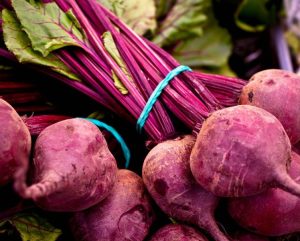 Beet, Red – Red beets are root vegetables known for their earthy flavor and vibrant red-purple color. They are rich in nutrients like folate, manganese, potassium, dietary fiber, and antioxidants such as betalains, which help reduce inflammation and support heart health. Both the roots and greens are edible, with the greens offering additional nutrients like vitamins A and C. Beets can be eaten raw in salads, roasted, boiled, or blended into smoothies and soups. Store beet greens separately from the root, wrapped in a damp cloth or in a plastic bag in the fridge. Use within a few days – they don’t keep long. Beetroots can be stored in a plastic bag in the fridge’s crisper drawer for up to two weeks. To freeze beets for longer storage, slice or chop them, spread on a cookie sheet to flash freeze, then transfer to freezer bags where they can be stored for up to a year.
Beet, Red – Red beets are root vegetables known for their earthy flavor and vibrant red-purple color. They are rich in nutrients like folate, manganese, potassium, dietary fiber, and antioxidants such as betalains, which help reduce inflammation and support heart health. Both the roots and greens are edible, with the greens offering additional nutrients like vitamins A and C. Beets can be eaten raw in salads, roasted, boiled, or blended into smoothies and soups. Store beet greens separately from the root, wrapped in a damp cloth or in a plastic bag in the fridge. Use within a few days – they don’t keep long. Beetroots can be stored in a plastic bag in the fridge’s crisper drawer for up to two weeks. To freeze beets for longer storage, slice or chop them, spread on a cookie sheet to flash freeze, then transfer to freezer bags where they can be stored for up to a year.
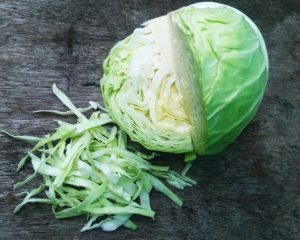 Cabbage, Green – Green cabbage is a nutrient-dense cruciferous vegetable in the Brassica family, known for its tightly packed, round, pale green leaves. It is rich in vitamins C and K, as well as fiber and antioxidants, which are beneficial for immune health, digestion, and bone strength. With a mild, slightly peppery taste, green cabbage can be enjoyed raw in salads and slaws, or cooked in stir-fries, soups, and stews. To store, keep green cabbage unwashed in a perforated plastic bag in the refrigerator’s crisper drawer, where it can stay fresh for up to two weeks.
Cabbage, Green – Green cabbage is a nutrient-dense cruciferous vegetable in the Brassica family, known for its tightly packed, round, pale green leaves. It is rich in vitamins C and K, as well as fiber and antioxidants, which are beneficial for immune health, digestion, and bone strength. With a mild, slightly peppery taste, green cabbage can be enjoyed raw in salads and slaws, or cooked in stir-fries, soups, and stews. To store, keep green cabbage unwashed in a perforated plastic bag in the refrigerator’s crisper drawer, where it can stay fresh for up to two weeks.
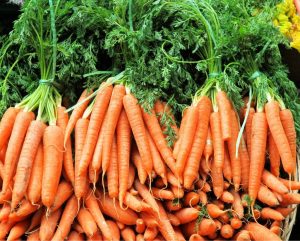 Carrot – Carrots are a versatile and popular root vegetable, known for their sweet, crunchy texture and vibrant orange color, though they can also be found in purple, yellow, and red varieties. They are rich in beta-carotene, which the body converts to vitamin A, essential for good vision and immune health. Carrots are a good source of dietary fiber, potassium, and antioxidants. Enjoy them raw, cooked, roasted, or juiced. They can be used in salads, soups, stews, and side dishes. For optimal storage, store carrots unwashed in the fridge, preferably in a plastic bag or container to maintain moisture, where they can last for several weeks. If the greens are attached, cut them off to prevent the carrots from becoming limp. Stored properly, they should last around 1-2 weeks.
Carrot – Carrots are a versatile and popular root vegetable, known for their sweet, crunchy texture and vibrant orange color, though they can also be found in purple, yellow, and red varieties. They are rich in beta-carotene, which the body converts to vitamin A, essential for good vision and immune health. Carrots are a good source of dietary fiber, potassium, and antioxidants. Enjoy them raw, cooked, roasted, or juiced. They can be used in salads, soups, stews, and side dishes. For optimal storage, store carrots unwashed in the fridge, preferably in a plastic bag or container to maintain moisture, where they can last for several weeks. If the greens are attached, cut them off to prevent the carrots from becoming limp. Stored properly, they should last around 1-2 weeks.

Carrot, Rainbow – In addition to the nutritional benefits above, rainbow carrots stand out from standard orange carrots with their vibrant colors—purple, yellow, red, and white—each offering unique nutritional benefits and distinct flavors. Purple carrots contain anthocyanins, powerful antioxidants linked to anti-inflammatory and heart-health benefits, with a slightly earthy, spicy taste. Yellow carrots are rich in lutein, which promotes eye health by protecting against macular degeneration and cataracts, and they have a mild, subtly sweet flavor. Red carrots contain lycopene, a potent antioxidant that supports heart health, reduces the risk of certain cancers, and helps protect skin from UV damage, with a richer, sweeter taste.
These colorful carrots are perfect for adding visual appeal to dishes and enhancing the taste profile, whether roasted to bring out their natural sweetness, or sliced raw for salads. Their distinct flavors can also add depth to juices and smoothies. The diverse hues, flavors, and nutrients of rainbow carrots make them perfect for garnishes or serving as part of a vegetable medley. Store rainbow carrots the same way you would store standard orange carrots.
 Celery – Celery is a crunchy, low-calorie vegetable known for its mild, slightly salty flavor. It is rich in vitamins K and C, folate, potassium, and fiber, supporting bone health, digestion, and hydration. Celery is often eaten raw as a snack, added to salads, or used as a base in soups, stews, and stir-fries. Store celery in the refrigerator, tightly wrapped in aluminum foil to retain its crispness, where it can stay fresh for up to two weeks. For longer storage, celery can be chopped and frozen.
Celery – Celery is a crunchy, low-calorie vegetable known for its mild, slightly salty flavor. It is rich in vitamins K and C, folate, potassium, and fiber, supporting bone health, digestion, and hydration. Celery is often eaten raw as a snack, added to salads, or used as a base in soups, stews, and stir-fries. Store celery in the refrigerator, tightly wrapped in aluminum foil to retain its crispness, where it can stay fresh for up to two weeks. For longer storage, celery can be chopped and frozen.
Don’t forget to use those celery greens! They’re a great addition to cooked beans, salads, eggs. Use leaves to make pesto or dry them and make your own parsley flakes, powder, or salt.
 Ginger – Ginger is a flavorful root widely used as a spice and natural remedy. It has a warm, slightly spicy taste and is rich in bioactive compounds like gingerol, which has anti-inflammatory and antioxidant properties. Ginger aids digestion, relieves nausea, and supports immune health. It is versatile in cooking and used in teas, curries, stir-fries, baked goods, and beverages. Store fresh ginger in a cool, dry place for short-term use or in the refrigerator in a paper towel or airtight bag for extended freshness. For long-term storage, freeze peeled or sliced ginger.
Ginger – Ginger is a flavorful root widely used as a spice and natural remedy. It has a warm, slightly spicy taste and is rich in bioactive compounds like gingerol, which has anti-inflammatory and antioxidant properties. Ginger aids digestion, relieves nausea, and supports immune health. It is versatile in cooking and used in teas, curries, stir-fries, baked goods, and beverages. Store fresh ginger in a cool, dry place for short-term use or in the refrigerator in a paper towel or airtight bag for extended freshness. For long-term storage, freeze peeled or sliced ginger.
Freeze your fresh ginger for longer storage: Peel and slice or grate the ginger. Freeze in an airtight container or ice cube tray. You can also freeze the whole unpeeled root in a freezer bag. Grate or slice directly from frozen as needed.
 Greens, Asian – Asian greens are a diverse group of leafy vegetables, including varieties like bok choy, gai lan, mizuna, and tatsoi, known for their tender leaves and mild, slightly peppery flavors. They are rich in vitamins A, C, and K, as well as antioxidants and fiber, making them a nutritious addition to meals. These greens are versatile and can be enjoyed raw in salads, stir-fried, steamed, or added to soups and noodle dishes. Store Asian greens in the refrigerator, ideally in a plastic bag or container with a damp paper towel to maintain freshness, and use them within a week for the best quality.
Greens, Asian – Asian greens are a diverse group of leafy vegetables, including varieties like bok choy, gai lan, mizuna, and tatsoi, known for their tender leaves and mild, slightly peppery flavors. They are rich in vitamins A, C, and K, as well as antioxidants and fiber, making them a nutritious addition to meals. These greens are versatile and can be enjoyed raw in salads, stir-fried, steamed, or added to soups and noodle dishes. Store Asian greens in the refrigerator, ideally in a plastic bag or container with a damp paper towel to maintain freshness, and use them within a week for the best quality.

 Kale – Curly kale and Lacinato kale are both nutrient-dense leafy greens packed with vitamins A, C, and K, along with fiber, antioxidants, and minerals like calcium and potassium. Curly kale has bright to deep green, ruffled leaves with a firm, fibrous texture, and a peppery, slightly bitter taste. Lacinato kale, also called Tuscan or dinosaur kale, has long, narrow, dark blue-green leaves with a bumpy, almost wrinkled texture and a milder, slightly sweet, nutty flavor. Both varieties are versatile—curly kale works well in salads, soups, smoothies, and sautés, while Lacinato kale shines in sautés, pasta dishes, and hearty soups like Ribollita (a Tuscan bread soup with vegetables and beans). Store unwashed leaves in a loose bag in the fridge’s crisper drawer, ideally wrapped in a damp paper towel, and use within 5–7 days. To extend freshness, blanch and freeze for later use in cooked dishes.
Kale – Curly kale and Lacinato kale are both nutrient-dense leafy greens packed with vitamins A, C, and K, along with fiber, antioxidants, and minerals like calcium and potassium. Curly kale has bright to deep green, ruffled leaves with a firm, fibrous texture, and a peppery, slightly bitter taste. Lacinato kale, also called Tuscan or dinosaur kale, has long, narrow, dark blue-green leaves with a bumpy, almost wrinkled texture and a milder, slightly sweet, nutty flavor. Both varieties are versatile—curly kale works well in salads, soups, smoothies, and sautés, while Lacinato kale shines in sautés, pasta dishes, and hearty soups like Ribollita (a Tuscan bread soup with vegetables and beans). Store unwashed leaves in a loose bag in the fridge’s crisper drawer, ideally wrapped in a damp paper towel, and use within 5–7 days. To extend freshness, blanch and freeze for later use in cooked dishes.
Fun fact: NASA has studied kale as a potential crop for space missions because of its high nutrient density. Per calorie, kale has more iron than beef and more calcium than milk. And one cup of raw kale has more vitamin C than a whole orange. (But don’t stop eating those other nutrient-packed foods!)

Lettuce, Loose Leaf – Leaf lettuce, known for its loose, leafy structure and mild, slightly sweet flavor, comes in green and red varieties. It is a low-calorie vegetable packed with vitamins A, C, and K, as well as folate and fiber, making it a nutritious choice for salads and wraps. Its tender leaves are best used raw in salads, sandwiches, or as a garnish. Store leaf lettuce in the refrigerator, loosely wrapped in a damp paper towel inside a plastic bag or container, and use it within a week to maintain freshness and crispness.
Mushroom Varieties
Store mushrooms in a paper bag or breathable container in the refrigerator, avoiding moisture buildup, and only wash them right before use to maintain freshness.
Mushrooms are super versatile in the kitchen. Here are 10 Things You Should Do With Mushrooms.
This roundup of 20 Mushroom Recipes has you covered with meal ideas for breakfast, lunch, or dinner.
Mushroom, Portobello & Cremini – Portobello mushrooms are mature versions of cremini mushrooms, offering a meaty texture and rich, earthy flavor. Cremini, also known as “baby bellas,” are younger, smaller, and have a firmer texture with a milder taste. Both are low in calories, fat-free, cholesterol-free, and provide B vitamins, selenium, potassium, and antioxidants. Portobellos are ideal for grilling, roasting, or as a meat substitute in burgers, sandwiches, or stuffed recipes. Creminis are great for sautéing, adding to soups, stir-fries, pasta dishes, or as pizza and salad toppings.
Mushroom, Shiitake – Shiitake mushrooms are prized for their rich, umami flavor and slightly chewy texture, making them a staple in Asian cuisine. They are low in calories, fat-free, and a good source of B vitamins, copper, selenium, and immune-supporting polysaccharides. Shiitakes are versatile and can be sautéed, stir-fried, grilled, or added to soups, stews, and sauces for a depth of flavor. They are popular in dishes like ramen, risotto, and dumplings, and are often used in vegetarian recipes for their meaty texture.
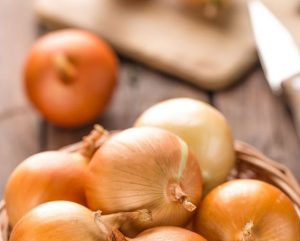
Onion, Yellow – Yellow onions are a popular, versatile vegetable with golden-brown skin and a strong, savory flavor that mellows and sweetens when cooked. Rich in antioxidants, vitamin C, and fiber, yellow onions support immune health, digestion, and overall cellular health. They’re a staple in many cuisines, perfect for sautéing, caramelizing, roasting, and adding depth to soups, stews, and sauces. To store, keep unpeeled yellow onions in a cool, dry, well-ventilated place, away from potatoes, where they can last up to a month; once peeled or cut, store them in an airtight container in the refrigerator for up to a week.
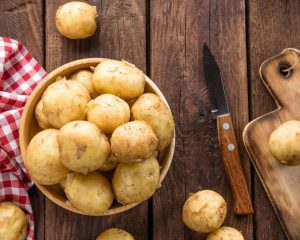 Potato, Yellow – Also known as Yukon Gold or gold potatoes, yellow potatoes have smooth, thin, yellowish skin and creamy, buttery-flavored flesh. They are slightly waxy, making them versatile in cooking. Yellow potatoes are a good source of vitamin C, potassium, and fiber and are low in calories and fat. Their creamy texture makes them ideal for mashing, roasting, grilling, and boiling. They are also excellent in gratins and salads because they hold shape during cooking. Store yellow potatoes in a cool, dark, and well-ventilated place for several weeks, avoiding refrigeration as it can alter their texture and flavor.
Potato, Yellow – Also known as Yukon Gold or gold potatoes, yellow potatoes have smooth, thin, yellowish skin and creamy, buttery-flavored flesh. They are slightly waxy, making them versatile in cooking. Yellow potatoes are a good source of vitamin C, potassium, and fiber and are low in calories and fat. Their creamy texture makes them ideal for mashing, roasting, grilling, and boiling. They are also excellent in gratins and salads because they hold shape during cooking. Store yellow potatoes in a cool, dark, and well-ventilated place for several weeks, avoiding refrigeration as it can alter their texture and flavor.
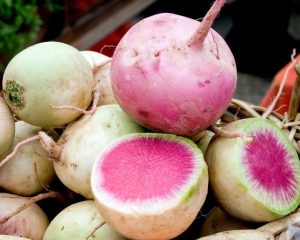 Radish, Watermelon – Watermelon radish is a striking root vegetable with a mild, slightly sweet flavor and a crisp texture. Its pale green skin hides a vibrant pink interior, resembling a watermelon. Rich in vitamin C, potassium, and antioxidants, it supports immune health and reduces inflammation. Watermelon radishes can be enjoyed raw in salads, sliced thinly for garnishes, pickled, or roasted for a milder flavor. Store unwashed watermelon radishes in a perforated plastic bag in the refrigerator, where they can stay fresh for up to two weeks. Wash and trim just before using.
Radish, Watermelon – Watermelon radish is a striking root vegetable with a mild, slightly sweet flavor and a crisp texture. Its pale green skin hides a vibrant pink interior, resembling a watermelon. Rich in vitamin C, potassium, and antioxidants, it supports immune health and reduces inflammation. Watermelon radishes can be enjoyed raw in salads, sliced thinly for garnishes, pickled, or roasted for a milder flavor. Store unwashed watermelon radishes in a perforated plastic bag in the refrigerator, where they can stay fresh for up to two weeks. Wash and trim just before using.
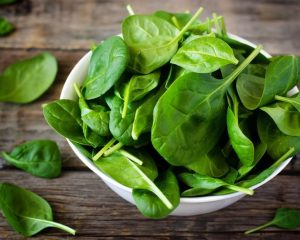 Spinach – Spinach is a nutrient-rich leafy green vegetable packed with vitamins A, C, K, and folate, along with minerals like iron and magnesium. Low in calories and high in antioxidants, it supports eye health, bone strength, and immune function. Spinach is versatile and can be enjoyed raw in salads, blended into smoothies, or cooked in soups, pasta, and omelets. To store, keep it dry in a perforated plastic bag in the fridge’s crisper drawer, and wash only before use. Properly stored, it stays fresh for 5-7 days.
Spinach – Spinach is a nutrient-rich leafy green vegetable packed with vitamins A, C, K, and folate, along with minerals like iron and magnesium. Low in calories and high in antioxidants, it supports eye health, bone strength, and immune function. Spinach is versatile and can be enjoyed raw in salads, blended into smoothies, or cooked in soups, pasta, and omelets. To store, keep it dry in a perforated plastic bag in the fridge’s crisper drawer, and wash only before use. Properly stored, it stays fresh for 5-7 days.
 Sweet Potato – Sweet potatoes are a nutritious root vegetable known for their naturally sweet flavor and vibrant orange flesh, though they also come in other colors like purple and white. They are rich in vitamins A (as beta-carotene), C, and B6, as well as dietary fiber, potassium, and antioxidants. These nutrients support eye health, boost immunity, and promote digestive health. Sweet potatoes are versatile in cooking and can be baked, roasted, mashed, or used in soups and stews. They can also be enjoyed in both savory and sweet dishes. Store sweet potatoes in a cool, dark, well-ventilated place for several weeks, avoiding refrigeration as it can affect their texture and flavor.
Sweet Potato – Sweet potatoes are a nutritious root vegetable known for their naturally sweet flavor and vibrant orange flesh, though they also come in other colors like purple and white. They are rich in vitamins A (as beta-carotene), C, and B6, as well as dietary fiber, potassium, and antioxidants. These nutrients support eye health, boost immunity, and promote digestive health. Sweet potatoes are versatile in cooking and can be baked, roasted, mashed, or used in soups and stews. They can also be enjoyed in both savory and sweet dishes. Store sweet potatoes in a cool, dark, well-ventilated place for several weeks, avoiding refrigeration as it can affect their texture and flavor.
 Swiss Chard (baby) – Milder and more tender than mature Swiss chard, baby chard is often used raw in salads, wraps, or grain bowls. While still rich in vitamins A, C, and K, it may have slightly less fiber than its fully grown counterpart. Store in a sealed container with a dry paper towel in the fridge and use within 3–5 days for the best freshness.
Swiss Chard (baby) – Milder and more tender than mature Swiss chard, baby chard is often used raw in salads, wraps, or grain bowls. While still rich in vitamins A, C, and K, it may have slightly less fiber than its fully grown counterpart. Store in a sealed container with a dry paper towel in the fridge and use within 3–5 days for the best freshness.
Fun fact: Chard is in the chenopod family which includes beets, spinach, and quinoa.
Don’t Forget: Online shopping opens Friday at 1 PM! 🛒 Stock your kitchen with these clean, nourishing ingredients to fuel your family with nutrient-dense meals. Be sure to grab your favorite staples and try something new for vibrant health this winter.
Don’t wait to join…
Veggie E-Books
Download these collections of tips and recipes for each veggie. You’ll use these as a reference throughout the season.
Arugula E-Book
Beets E-Book
Carrots E-Book
Kale E-Book
Lettuce E-Book
Mushrooms E-Book
Onions E-Book
Potatoes E-Book
Radish E-Book
Spinach E-Book
~~~~~
Farm News and Events
🍀 St. Patrick’s Day Farm-to-Table Dinner with Roll With It Catering
Join us Wednesday, March 19, 2025, from 6:00 – 8:30 PM for a festive 4-course, farm-to-table dinner filled with Irish-inspired dishes. Wear your best green outfit and get ready for a night of fun, good conversation, and delicious food. Tickets are $60. See our Facebook event page for more details.
~~~~~
Learn The Art of Pysanky Egg Decorating
Pysanky is an ancient Ukrainian tradition that celebrates the cycles of nature and life, using motifs inspired by these themes. Designs are created with simple tools like kistkas, beeswax, candlelight, and vibrant dyes, This workshop invites participants to explore the craft in a freeform style, using symbolism to tell a specific story and hold a deliberate intention.
Join us Saturday, March 22, 2025, from 9:00 AM – 12:00 PM and create a symbolic piece of art believed to bring Peace!
- Cost: $40 per session – all supplies will be provided.
All profits will be donated to Ukranian Peace Missions. - Please bring your own container to take your egg home.
- Registration is required. Space is limited to 12 individuals.
Register in person at Willow Haven Farm General Store, or by emailing WHFGeneralStore@gmail.com.
Ages 12 and up ONLY.
~~~~~
🍞 Next Sourdough Bread Baking Workshop – Sign Up!
Get ready for a fun, hands-on experience in the art of sourdough bread making!
Join us on Saturday, March 29, 2025, for our Sourdough Bread Baking Workshop at Willow Haven Farm.
Whether you’re a beginner or a seasoned baker, this workshop will give you the skills and confidence to bake delicious, homemade sourdough bread from scratch.
 👩🍳 What to Expect on March 29th:
👩🍳 What to Expect on March 29th:
- Step-by-step guidance from our expert instructor
- Hands-on experience making your own sourdough starter
- Tips for perfecting your bread at home
- A chance to meet other bread enthusiasts in a fun, relaxed environment
✨ Don’t miss out on this opportunity to take your baking to the next level!
We’ll keep farming for you!
Reuben and Tessa DeMaster
Willow Haven Farm


